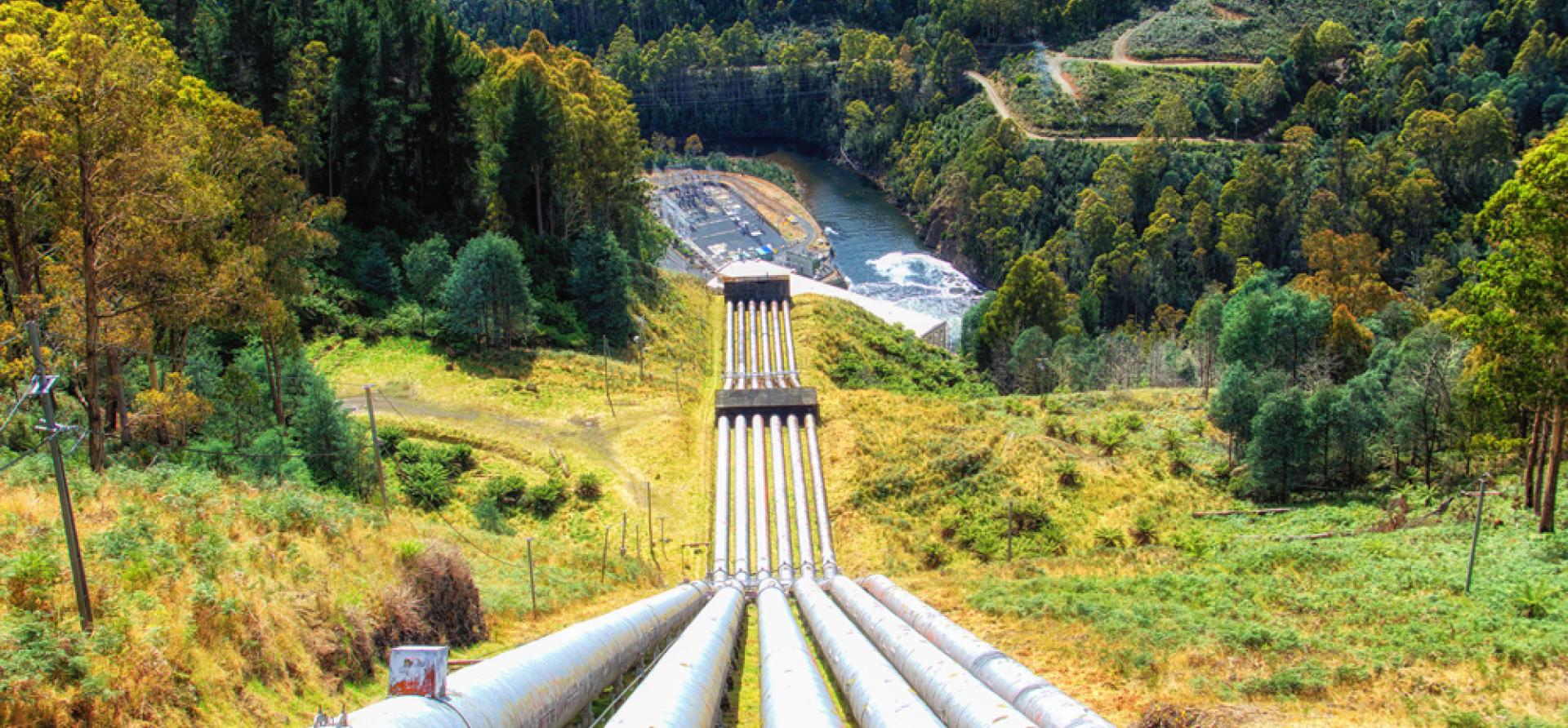
Key Findings
Tasmania could significantly reduce its energy costs by optimising
its energy assets: importing more cheap electricity, exporting more high-priced electricity, and slashing electricity costs of residential
and commercial buildings.
By optimising its existing and planned assets, Tasmania could multiply its winter exports five-fold, meeting up to 18% of Victoria’s maximum daily winter electricity demand.
Improving the energy productivity of its buildings and expanding renewable generation would help Tasmania to ‘hoard water’ in existing dams, freeing up hydro generation for higher-value uses.
Batteries could help Tasmania cost-effectively increase both imports and exports of energy, while a broader review of market incentives and rules may be required to optimise the opportunity represented by water hoarding.
Executive Summary
With its ‘Battery of the Nation’ project, Tasmania is seeking to become a key source of electricity storage for mainland Australia by maximising the state’s hydro power capacity.
Hydro generation is a valuable asset as it can provide dispatchable, zero emissions electricity and long-duration storage. Today, however, Tasmania’s hydro generation is used in large volumes to meet local daily electricity demand. This report investigates how it could be better utilised at times of higher value for the whole Australian energy system, with significant benefits for Tasmania.

In future, Victoria will likely have an increasing need for seasonal electricity storage, with higher electricity demand in winter, and higher renewable generation in summer. Victoria’s ambitious emissions reduction targets and fast-declining gas reserves make it important to develop zero emissions, cost-effective electricity solutions to complement this seasonal profile.
Tasmania already provides substantial seasonal storage profitably for mainland Australia. In recent years, it has imported electricity via the Basslink interconnector in summer and exported hydroelectricity in winter. However, these imports and exports are often materially lower than Basslink’s capacity of around 500 megawatts (MW). In principle, there is scope to increase Basslink utilisation. We analysed which factors may drive or constrain imports and exports.
We found that low water storage reserves sometimes seem to constrain winter exports, as reserves must be maintained at a certain level to ensure energy security for the state. However, it seems that Tasmania has substantial unutilised water storage capacity. The two major lakes within the hydro generation system, which offer the best opportunity for long-term water storage, utilised less than 45% of their total capacity over the last six years. This represents unused long-term storage of up to 6,200 gigawatt-hours (GWh). To make greater use of this storage capacity, some water could be ‘hoarded’ – not releasing it from the lakes to generate power for daily Tasmanian demand, which is met instead with demand reduction options or alternative electricity supply sources.
Another major driver for utilisation of Basslink seems to come from the financial attractiveness of imports and exports. While operational or environmental factors (such as rainfall and water storage levels) have some influence over levels of imports and exports, financial considerations also exert a large influence. Large export volumes often seem to correspond to times of high mainland wholesale prices, while large import volumes often coincide with low or negative mainland wholesale prices. This presents a pricing arbitrage and revenue opportunity for the government-owned electricity generator Hydro Tasmania, but it means Basslink utilisation is not at its maximal level.
Various actions could increase seasonal imports and exports
IEEFA’s report explored ways in which seasonal import and export levels could be increased.
Energy productivity: We examined ways in which water hoarding could be increased by reducing local electricity demand through profitable, socially beneficial energy productivity improvements. The heating of buildings accounts for a significant share of Tasmanian winter electricity use. The state uses more electricity in winter than other regions with similar climates, partly due to inefficient electric heating equipment. Resistive heating remains dominant and consumes three to five times more electricity than reverse cycle air conditioners (RCACs). Recent IEEFA analysis found that each year of delay to shift to efficient appliances is costing Tasmanian households $146 million in additional lifetime costs.
Upgrading Tasmania’s aging building stock could also deliver significant savings. Recent research shows that detached homes with timber framing, which are common in the state, offer the largest, most cost-effective target for building upgrades. Improving thermal and equipment efficiency could yield significant energy and peak demand savings, as well as health and comfort benefits, especially for the least efficient buildings. Heating electricity use could be decreased by 70%, even accounting for increased consumption for improved comfort. Similar savings could be gained by upgrading water heating equipment from resistive to heat pumps.
There is also likely to be large potential to improve winter energy performance in the commercial sector. Commercial buildings are typically poor thermal performers in extreme weather, with significant energy distribution losses from central heating and hot water systems.
Together, residential and commercial energy efficiency improvements could deliver annual energy savings of about 1,200GWh, some of it at times of high electricity demand.
New renewables: IEEFA explored how planned new Tasmanian generation capacity could also increase water storage reserves. The state plans to double renewable energy production and reach 200% of its electricity needs by 2040. This would mean an additional 10,500GWh of renewable generation per year, which would decrease the requirement to use hydro generation to meet daily Tasmanian demand, leaving more water in storage. This would free up hydro power to be used at times of highest potential benefit for Tasmania.
Mainland battery storage: The report explored how Tasmania could profitably export more electricity by utilising mainland battery storage as ‘virtual transmission’ capacity to increase Basslink utilisation. It would allow Hydro Tasmania to increase undersea cable utilisation for imports and exports by charging the mainland battery when mainland prices or demand are relatively low, then feed it to Tasmania when cable capacity is available or into the mainland grid when prices are high. Such batteries are likely to be more cost-effective and present lower implementation risk than increasing transmission capacity. They could help Tasmania access low wholesale spot prices from the mainland.
Marinus: We briefly analysed the additional export opportunity provided by the 750MW Marinus 1 undersea cable from Tasmania to the mainland. Federal and Victorian governments have committed to helping fund Marinus. This would more than double current interstate transmission capacity. Similar actions could be taken to optimise its usage.
Maximising storage could benefit Victoria and Tasmania
The report then estimated the scale of the opportunity. We calculated the potential uplift in winter exports that could be realised through these interventions. We found that there seems to be more than enough potential to displace hydro generation and allow water to be ‘hoarded’ in existing Tasmanian dams, within environmental limits. We also found that by optimising Basslink and Marinus 1 capacity, winter exports could be increased five-fold to more than 5,000GWh per year. Energy productivity improvements alone would free up enough hydro generation to optimise Basslink exports.
Just utilising Basslink at full capacity could meet 8% of the average Victorian winter weekly demand, or 7.5% of maximum weekly demand. If Marinus 1 is built, we calculated that exports from Tasmania could meet 20% of average Victorian winter weekly demand, 19% of maximum winter weekly demand in Victoria, and 18% of Victorian maximum daily winter demand.
Maximising the value of Tasmanian hydro generation could therefore deliver material benefits for Victoria’s electricity system. It could also deliver large benefits for Tasmania by increasing government revenue from its hydro generation assets, as well as delivering lower electricity bills and improved comfort for Tasmanian households.
Potential Tasmanian exports to Australian mainland compared with Victorian weekly winter demand (average and maximum across June-August period)

While some financial incentives are already available to capture this potential, they may not be sufficient to drive the behaviours required to optimise the system benefits. In particular, the interventions and investments suggested in this report would require coordination by a number of actors, including Hydro Tasmania, the Tasmanian government, as well as public or private owners of new batteries in Victoria. Regulatory changes may also be required.
IEEFA recommends that the Australian Energy Market Operator (AEMO), as well as relevant state energy bodies such as VicGrid and Victoria’s State Electricity Commission (SEC), further investigate these issues. This would require more detailed modelling of the potential to confirm the findings from this report, accounting for the full complexity of Tasmania and Victoria’s electricity systems, as well as a review of current regulatory and market settings.















